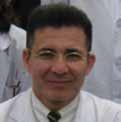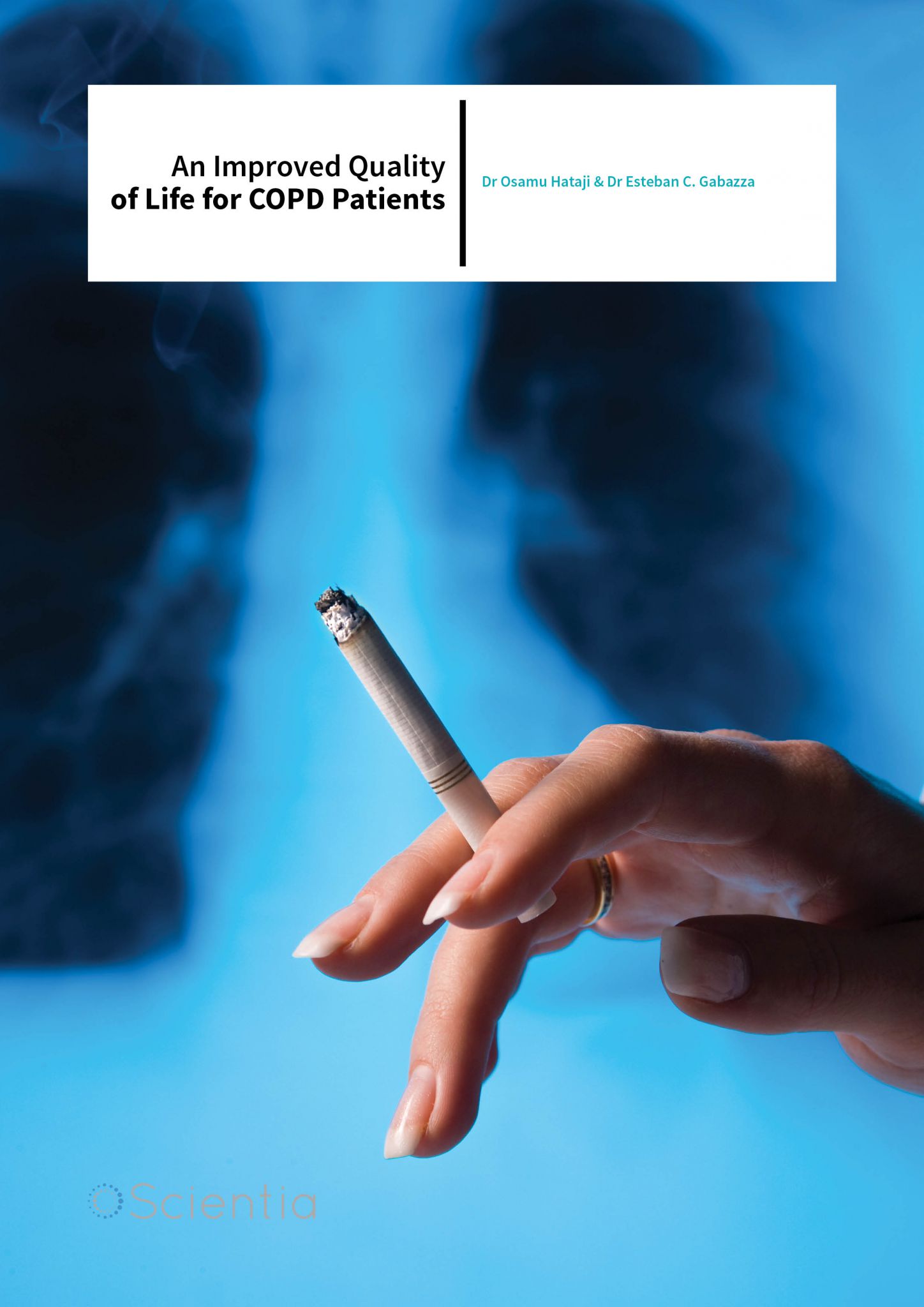Dr Osamu Hataji – An Improved Quality Of Life For Copd Patients
Dr Osamu Hataji is a physician who diagnoses and treats various respiratory and lung diseases. Dr Esteban C.Gabazza is a professor with expertise in inflammation and the immune system. Here, they discuss COPD treatment and how they are working together to assess physical activity in COPD patients as a method of treatment.

Dr Hataji, as a clinician, could you tell us about what it was that first drew your interest to medical research?
During my routine clinical practice, I encounter many challenges. This involves not only assessment and diagnosis of a patient’s symptoms and conditions, but also trying to identify other potential underlying causes. Much of my passion and attention has been focused on the work of pursuing and ultimately capturing such “truth”.
Your trial investigates a drug that has the potential to improve the treatment of chronic obstructive pulmonary disease (COPD). Could you please explain the major causes and prevalence of this condition, and tell us about the impact that it has upon a patient’s quality of life?
The main cause of COPD is smoking, and the mortality of COPD is highly associated with a patient’s level of physical activity. COPD patients have difficulty breathing and, as a result, become less and less physically active. This lack of physical activity then causes even more difficulty in breathing. It’s a vicious cycle that, unfortunately, many patients often fall into. And this is precisely why bronchodilators are so important for improving a patient’s breathing and overall health. However, as we make use of bronchodilators, it is important for us to closely monitor patients in order to evaluate improvements in their level of physical activity.
Dr Gabazza – you have research interests throughout the field of immunology. What brought COPD to your attention and how does that fit within the larger scope of your research.
After I took up my current position as Head of the Immunology Department I built up a large research group consisting of basic scientists and clinicians. Initially we focused on asthma, and we have gradually moved towards COPD as the needs are greater in this area of research. I have always been aware that COPD is a major clinical problem, and at the time I got involved in this research very little was known about the underlying cellular and molecular mechanisms, and so we developed a new animal model to look at the nature of the inflammatory response in COPD. The promise is that our research will lead to new treatments. Contrary to asthma, therapy for COPD is less effective and there are no drugs that repress the chronic inflammation and lower progression and mortality of COPD.
In this study you evaluate the effect of indacaterol on daily physical activity in patients with COPD. Could you please explain the rationale behind routine physical activity as a measure of the efficacy of indacaterol treatment?
The mortality of COPD is highly associated with a patient’s level of physical activity. Bronchodilators significantly improve pulmonary function, physical endurance and subjective symptoms. However, there has not been any report as to whether bronchodilators can improve patients’ physical activity level. That is why I decided to conduct research to find out whether indicaterol can improve a patient’s level of physical activity.
How does indacterol act to alleviate the symptoms of COPD? How does this improve upon traditional bronchodilators?
Indacaterol works as a broncodilator. In the past, anticholinergic agents were used as the first line treatment for COPD; failing that, beta-agonists were considered the next best choice. As it turns out, for treating COPD, however, beta-agonists are considered to be generally ineffective. That said, ultra-longacting beta(2)-adrenoceptor agonists, such as indicaterol, have actually been found to be as good, if not better, when compared with anticholinergic agents.
Dr Gabazza – Your laboratories’ research theme is ‘The development of new strategies to prevent and cure chronic inflammatory diseases’, in addition to COPD, what are your other promising areas of research?
Our focus is to clarify the molecular and cellular mechanisms of inflammatory responses in environmentally (including cigarette smoking and alcohol drinking) and intrinsically stimulated organs. We are particularly interested in the functional relationship between inflammation and the coagulation-fibrinolysis system. We try to figure out the behaviour and function of dendritic cells under the control of coagulation factors, and to reveal mechanisms of immune activation. In order to obtain outcomes that can be utilized to resolve pathogenicity, and to prevent human diseases, we adopt the latest technologies and devote ourselves to our research.
TREATING COPD BY IMPROVING PHYSICAL ACTIVITY
COPD (chronic obstructive pulmonary disease) is a common ailment that affects current and past smokers and currently there is no cure. Treatments for COPD improve some of the symptoms, but more need to be done to improve the quality of life for these patients. Dr Osamu Hataji, director of the Respiratory Center, Matsusaka Municipal Hospital, and Dr Esteban C. Gabazza of the Mie University Faculty and Graduate School of Medicine are working to develop ways to monitor the physical activity in patients with COPD before and after the use of drug treatments.

COPD and the Vicious Cycle
COPD stands for chronic obstructive pulmonary disease. A person with COPD has a hard time breathing, and this gets worse as time goes on. COPD causes excess mucus to be produced due to coughing, and also leads to wheezing, shortness of breath and tightness of the chest. The leading cause of COPD is cigarette smoking. Most people with COPD have smoked in the past or are current smokers. The prevalence of COPD is high. It affects more than 10% of the population worldwide and is expected to be the 3rd leading cause of death by 2020. COPD develops slowly. The science behind COPD involves a chronic inflammatory process. This means that there is an excess of immune cells in the airway of the lungs that cause damage to the tissue. This damage limits the normal airflow in the lungs. One of the main complaints from COPD patients is a shortness of breath and this hinders physical activity, which worsens the quality of life for these patients. To improve the symptoms of COPD, patients are told to increase their physical activity. The problem is patients with severe COPD are often unable to perform basic activities like walking, cooking, or taking care of themselves. This lack of physical activity increases the difficulty in breathing, which is a vicious cycle that, unfortunately, many patients often fall into.
Treatment for COPD patients
Currently, there is no cure for COPD, and therefore, a major research goal is to find treatments that reduce symptoms and improve the quality of life for the patients. Current treatments include bronchodilators, rehabilitation and home oxygen therapy. Inhaled long-acting bronchodilators are very effective at improving symptoms, exercise capacity and the quality of life, as well as for preventing exacerbations. Although, it is unknown whether bronchodilators improve a patient’s physical activity level. This is where the work of Drs Hataji and Gabazza comes into play. Together, with their colleagues, they conducted a study using the drug indicaterol to determine if the drug improved a patient’s level of physical activity.
Indacaterol is a type of drug called a ß2-agonist and it functions as an ultra-long-acting bronchodilator that has an established clinical efficacy and safety profile. It was approved for clinical use by the European Medicines Agency in 2009 and by the US Food and Drug Administration in 2011. This drug only needs to be administered once a day, and for patients with moderate to severe COPD, it significantly improves the symptoms, pulmonary function test results, and quality of life. In addition, recent studies have demonstrated that indacaterol might also improve exercise endurance in COPD patients. The effect of this drug on daily physical activity in these patients is not well understood.

Assessing physical activity as part of COPD treatment
Movement of the body that is produced by skeletal muscle contraction and leads to energy expenditure is referred to as physical activity. When evaluating the therapeutic response in patients with COPD, the level of physical activity during routine daily life is now recognised as an important outcome parameter. Patients with limited physical activity have more hospitalisations because of exacerbations, and signs of physical activity predict mortality in patients with COPD. In the past, researchers have validated the use of accelerometers (devices that detect motion) to obtain an objective measurement of physical activity in patients with the disease. In the study conducted by Drs Hataji and Gabazza, they assessed the effect of indacaterol on the daily physical activity of patients with COPD using a uniaxial accelerometer.
Their study included 23 patients with COPD who were part of the outpatient department at the Matsusaka Municipal Hospital in Japan. All of the patients were former smokers and, at the time of the study, were not using any pharmacotherapies to help them stop smoking. All of the patients had stable disease with no exacerbations prior to or during the study. The study design was set up so that 14 of the patients received tiotropium, which is a long-acting, 24-hour, anticholinergic bronchodilator that is used in the management of COPD together with indacatoerol and the remaining 9 patients received indacatoerol alone. The study design is considered as an open-label clinical trial with no randomisation, no placebo group and no blinding.
In order to record and assess the physical activity changes in the patients, a Lifecorder, which is a uniaxial accelerometer, was attached to their belts for 4 weeks before they started receiving the indacaterol therapy and then for another period of 4 weeks while they were receiving treatment with the inhaled indacaterol. This was a way to compare the physical activity of the patients before and after treatment with indacaterol.
The Lifecorder measured the number of steps, the duration of moderate or higher degree exercise, the energy expenditure and the metabolic equivalent of task in all of the patients before and after treatment. In all of the patients, the number of steps, the length of moderate or more activity and the energy expenditure all were significantly increased after treatment compared with before treatment. In addition, the metabolic equivalent of task was also significantly improved after treatment with indacaterol compared with before the treatment, suggesting that this ß2-agonist improves routine daily activity in patients with COPD. Drs Hataji and Gabazza used a novel accelerometer that had been previously evaluated for sensitivity and efficacy. They suggest that the use of this novel accelerometer is effective for assessing the daily physical activity of COPD patients because it is easy to use, cost-effective and can record data in a realtime basis over a long period of time.

COPD patients have difficulty breathing and, as a result, become less and less physically active. This lack of physical activity then causes even more difficulty in breathing. It’s a vicious cycle.
The Future of Physical Activity Assessment: The Smart Watch
According to the World Health Organization (WHO), it is recommended that within a week’s time span all adults should participate at least 150 minutes of moderate-intensity aerobic activity, like walking, in order to maintain a healthy lifestyle. For patients with a medical condition like COPD, this is a difficult task. The 2013 Global Initiative for Chronic Obstructive Lung Disease (GOLD) strategy advised that all patients with COPD should participate in daily physical activity, but the level at which the activity it supposed to be conducted was not defined. Even with such recommendations, patients with COPD report less physical activity compared to patients with other diseases, such as rheumatoid arthritis and diabetes. The assessment of that physical activity is also part of the puzzle, as Drs Hataji and Gabazza have alluded to. Objective measures of assessing physical activity continue to be investigated through clinical evaluation and validation. Accelerometers, like the one used in the study described above, are electronic devices that are generally worn on the arm (like an armband) or waist. There is still limited evidence for the reliability, validity, and responsiveness of accelerometers in COPD patients. There are suggestions that they are sensitive to artefacts, observation bias and compliance issues. This suggests that there is room for improvement, as with any technology.
In a recent study by Drs Hataji and Gabazza, they evaluated the use of a Smart watch to evaluate physical activity in COPD. The validation of the Smart watch was done by correlating the results with data obtained from two types of accelerometers. For this study they monitored 10 male patients with stable COPD from the outpatient department of the Matsusaka Municipal Hospital in Japan. All of the patients were former smokers and were not undergoing any active therapy to stop smoking. The Smart watch, with a built in accelerometer, was compared to a uniaxial accelerometer, the Lifecorder and the triaxial accelerometer, the Actigraph. Each device measured the number of steps, the energy expenditure in calories, the time of exercise and the distance walked. The results demonstrated that the number of steps and the amount of calories measured by the Lifecorder and Actigraph was significantly correlated with all of the Smart watch activity parameters. These findings reveal that the capacity to monitor physical activity in COPD patients by wearable Smart watches is comparable to devices that are generally used in clinical practice, such as the accelerometers used in thus study.
As an added measure, Drs Hataji and Gabazza also confirmed the correlation between the pulmonary function tests and the physical activity variables measured using each device. They found that the physical activity variables measured on the Smart watch reflected the lung function in a manner similar to the currently used devices. In fact, some of the Smart watch variables reflected lung function even better than the Actigraph.
The use of Smart watches has become quite popular in the general population.
This recent study by Drs Hataji and Gabazza demonstrates how the potential applications of popular technologies can be investigated for use in in routine clinical practice. Significant correlation was found between the corresponding parameters of the Smart watch and traditionally-used devices, which suggests the potential applicability of Smart watches for monitoring physical activity in COPD patients. Future studies in a larger population will be required to confirm these findings.
What’s next?
According to Dr Hataji, indicaterol is not the only bronchodilator he and his team are looking into. There are a few other bronchodilators that are currently being developed, and he would like to learn more about such treatment options. In addition, his group plans to conduct more studies to understand whether mortality decreases as the level of a patient’s physical activity improves or increases.
Dr Gabazza states that his lab focuses on clarifying the molecular and cellular mechanisms of inflammatory responses in environmentally (including cigarette smoking and alcohol drinking) and intrinsically stimulated organs. He and his colleagues are particularly interested in the functional relationship between inflammation and the coagulationfibrinolysis system. His team is searching for pharmacological control of inflammatory diseases and cancer and aims to apply these findings to clinical innovation that facilitates establishment of strategies for regulating the immune cells involved in disease progression.
Drs Hataji and Gabazza are clearly tackling a multitude of issues that surround COPD and this approach is sure to yield promising results for patients in the future.
Meet the researchers

Dr Osamu Hataji
Director of the Respiratory Center Matsusaka Municipal Hospital Japan
Dr Osamu Hataji diagnoses and treats various respiratory and lung diseases. He conducts a variety of clinical trials for respiratory diseases for promoting the development of new drugs. His team carries out multidisciplinary treatments in all areas, including respiratory medicine, respiratory surgery, radiology and rehabilitation.

Dr Esteban C. Gabazza
Professor of medicine and Chairman Department of Immunology Mie University Faculty and Graduate School of Medicine Japan
Dr Esteban C. Gabazza develops new strategies to prevent and cure chronic inflammatory diseases. He focuses on allergic airway inflammation (asthma), chronic obstructive pulmonary disease (COPD), pulmonary fibrosis, diabetes mellitus, atherosclerosis, fatty liver and cirrhosis, etc. Some of this research has progressed to explore the control mechanism of chronic inflammation.
KEY COLLABORATORS
Prof Dr Osamu Taguchi, Mie University School of Medicine, Japan
Dr Yoichi Nishii, Matsuzaka Municipal Hospital, Japan
Prof Dr Isaac Cann, Illinois University, USA
FUNDING
Grant-in-aid from the Ministry of Education, Culture, Sports, Science, and Technology of Japan
REFERENCES
Hataji O, Kobayashi T, and Gabazza EC, Smart watch for monitoring physical activity in patients with chronic obstructive pulmonary disease, Respiratory Investigation, Available online 17 March 2016. Joos GF and Gabazza EC., Is there still hope for single therapies: how do we set up experimental systems to efficiently test combination therapies?, Respirology, 2015, 15–23. Chelakkot-Govindalayathil AL, Mifuji-Moroka R, D’Alessandro-Gabazza CN, Toda M, Matsuda Y, Gil-Bernabe P, Roeen Z, Yasuma T, Yano Y, Gabazza EC, Iwasa M and Takei Y., Protein S exacerbates alcoholic hepatitis by stimulating liver natural killer T cells, J. Thromb. Haemost., 2015, 142–54.
Watanabe F, Hataji O, Ito K, D’Alessandro-Gabazza CN, Naito M, Morooka H, Gabazza EC, Mizutani Y, Ohi M, Takao M, Shimpo H, Yada I., Three-dimensional computed tomography angiography for the preoperative evaluation of coronary artery disease in lung cancer patients, World J. Surg. Oncol., 2013, 164.
Maruyama T, Fujisawa T, Okuno M, Toyoshima H, Tsutsui K, Maeda H, Yuda H, Yoshida M, Kobayashi H, Taguchi O, Gabazza EC, Takei Y, Miyashita N, Ihara T, Brito V and Niederman MS., A new strategy for healthcare-associated pneumonia: a 2-year prospective multicenter cohort study using risk factors for multidrug-resistant pathogens to select initial empiric therapy, Clin. Infect. Dis., 2013, 1373–83.



